History of the railway operations laboratory
1951 – 1954
In 1951, the first test facility was built in Dresden based on the existing facility in Darmstadt (1937). This consisted of the Erika station and the Steigerwald block. The system could only be operated in one direction. Unlike today, the focus of research at that time was not on railroad operations. Rather, it was a test facility for developed model locomotives and elements of the railroad infrastructure. The main areas of focus may be summarized as follows:
- Testing model locomotives esp. regarding running safety
- Testing of model interlockings
- Development and testing of switches, switch drives, locomotives and track elements for the training operation
- Testing of train contact: Magnetic switch
In addition to the facility described above, a test facility for driving dynamics purposes was also built. This was housed in a workshop room and was used for functional testing of the track material and switch drives that had been created.
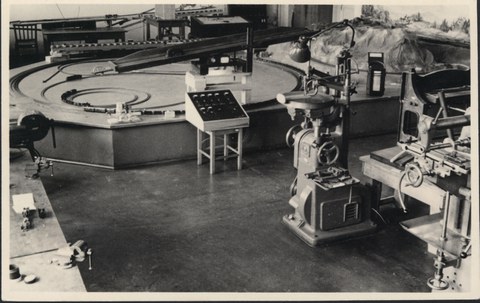
Workshop and test facility
The facility consisted of the following elements:
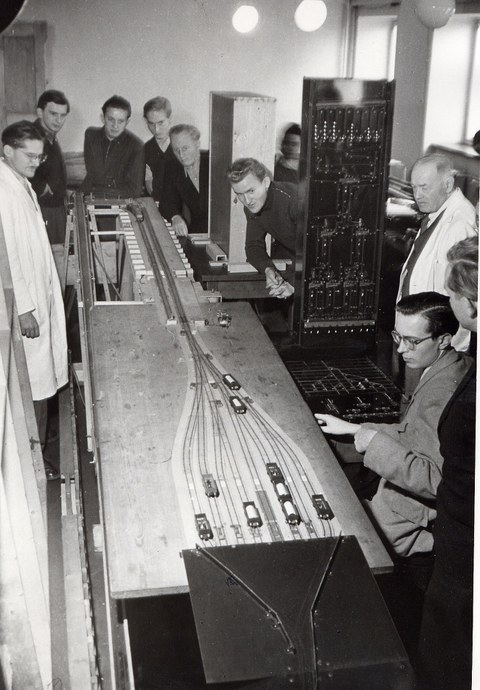
Gravity yard of the test facility
- gravity yard
- various curve radii
- ramp with variable gradient
In addition, there was an apparatus for determining the relationship between arc radius and tensile force.
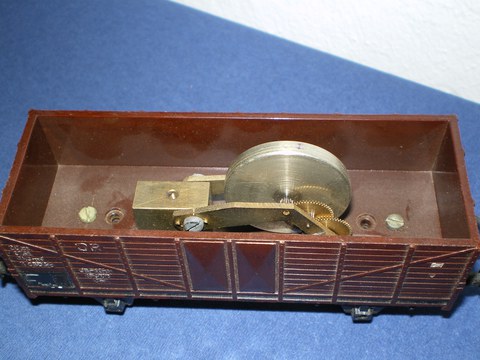
special trolley with flywheel mass
1951 – 1954
In 1954, a new facility was opened in the building shell. This was located in the area where the Waldhof, Neustadt and Adorf stations are located today. There were 7 stations which were named alphabetically according to species of plants. The stations Aster, Birken, Erika and Hasel, the stop Clematis and the block stations Dornbusch and Fichtengrund.
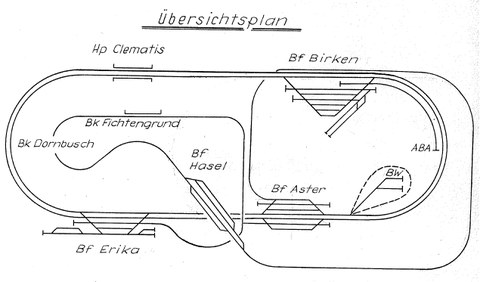
Track plan 1954
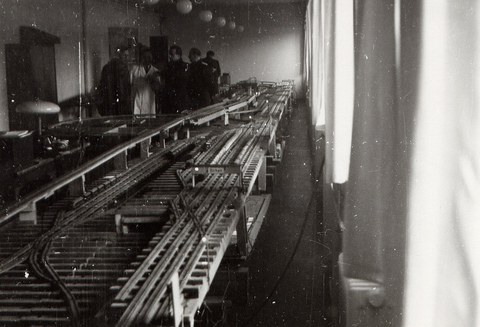
Facility after completion of the shell and the track plan

Fully modeled facility
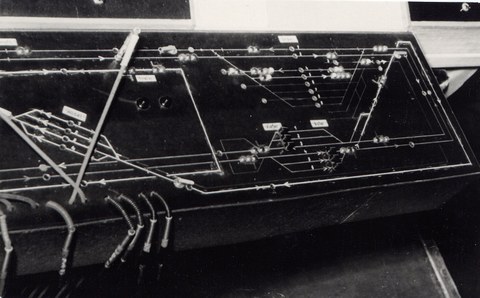
Control panel
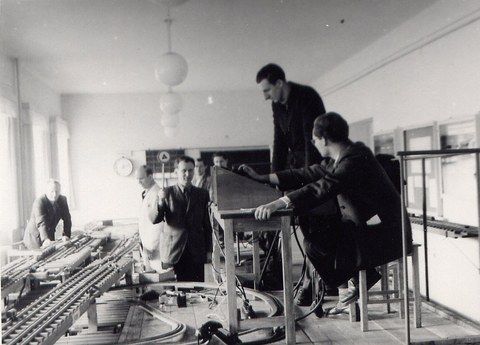
Departure order to locomotive driver
During operations, a distinction was made between train crews and signalmen. The locomotive drivers sat at an elevated console on which there were 6 control units. These could be connected to the power sections on the facility and the locomotives could be controlled in this way.
The signals were sometimes difficult for the locomotive drivers to see, as they had to overlook the entire room. The dispatchers sat in front of improvised or replica interlockings and had telephones for train announcements.
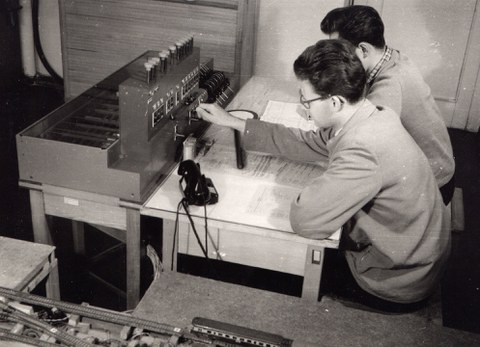
self-built interlocking Erika (based on a mech. interlocking)
1963 - 2000
In 1963, the first facility was inaugurated at the site of today's University of Applied Sciences (HTW). It consisted of 2 tracks at different heights. Originally, it was planned to display these lines in different colors (black: double-track; green: single-track), but this idea was discarded:
The name of the stations was changed to Adorf and Zellwald. The main line was a continuous double-track, ring-shaped line, which connected the stations Adorf and Zellwald. The Schwarzburg, Schwarzfeld and Schwarzhain stations were also to be located on this line. This line was 155 m long, which corresponded to about 31 km of track. Adorf and Zellwald simultaneously marked the beginning and end of the single-track line, which was lowered down and enclosed the double-track line in a "C" shape. In between, the stations Grünland, Grünmarkt, Grünstadt and Grüntal were planned on the single-track section. The single-track section had a length of 130 m, which corresponded to about 26 km.
Here you can see the track plan of the actually built facility:

Track plan of the facility at the site of today's HTW.
Stations:
- Adorf - Relay interlocking Sp64b2 of type II
- Zellwald - electromechanical interlocking (train dispatcher and switchman)
- Weinstadt - Relay interlocking of type I
- Schwarzburg - Relay interlocking of type II
- Dornbach - mechanical interlocking (train dispatcher and switchman)
- Grüntal - electromechanical interlocking (train dispatcher and switchman)
With the exception of Grüntal and Schwarzburg, the interlocking technology was carried over from the previous facility. Driving personnel (outside) and interlocking personnel (inside) were separated. Furthermore, there was a controller's workstation in an extra room. The controller could reach every dispatcher through an all-points station and had the graphic timetable in printed form.
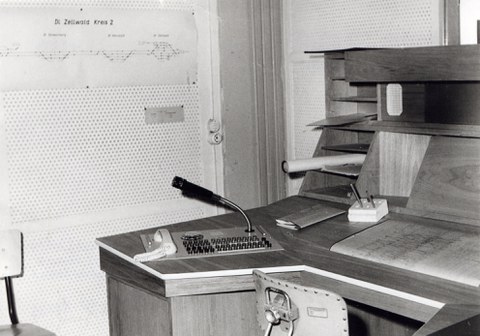
Controller work station
Some facts about the facility:
- 440 m track
- 40 switches (+ 17 double switches)
- 53 semaphore signals
- 20 light signals
- 30 manual control locomotives
- 50 passenger and 120 freight cars
- 6 stations with 9 interlockings (approx. 1000 relays) 37 km of wire
The following figure shows a part of the laboratory in 1996. The different tracks can be clearly identified due to the different heights. Below is the single-track line and in the background the double-track ring can be seen. Furthermore, one can see the arrangement of the interlockings inside and the driving personnel outside.

Test line
The picture also shows the LZB test line installed in the first half of 1994 which already was operated digitally using the Selectrix system, as it is today. For this line, there was an extra computer that controlled the vehicles and thus no locomotive crew was required. There were two operating stations on the line: the Neustadt station and the Schwarzburg Wilhelmshöhe transfer station. Both were controlled by an electronic interlocking (ESTW) in Neustadt.

Workplace at the electronic interlocking Neustadt
A track loop was also connected to the upper, right-hand end of the rail layout so that the trains may turn around.
Next to the layout there was also a test field with a model of a connecting railway for a larger steelworks. This included a measuring section for model wagons that had been run or pushed off.
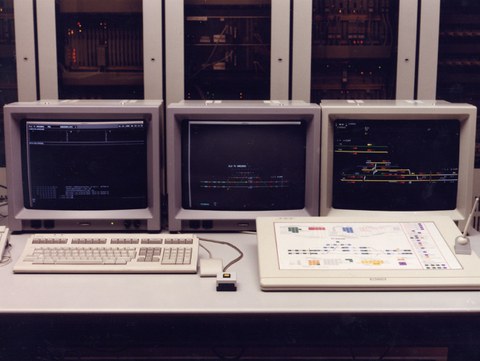
Control terminal for the ESTW
2000 – Present
The current facility of the Railway Operations Laboratory (EBL) is located at TU Dresden and is part of the Integrated Railway Laboratory (IEL) of the Faculty of Transport Sciences "Friedrich List".
After a one-year break for new construction and relocation, teaching resumed in the winter semester 2001/2002 in the current premises.
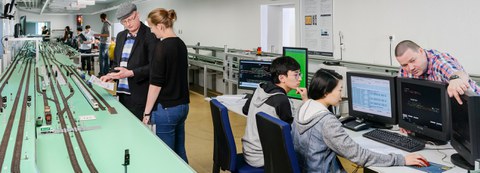
Current installation
